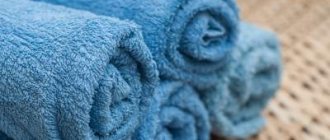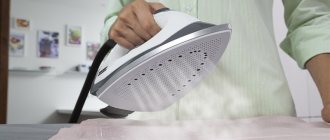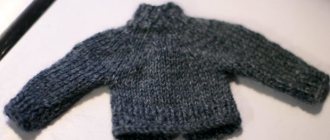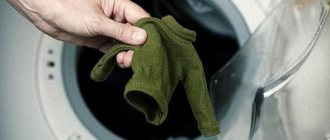Terry towels may lose both their appearance and the softness of the fabric after washing. Restoring products often requires a lot of effort. The set of measures, in addition to chemicals, often includes folk formulations. The effect of each of them must be verified through testing. Every housewife should know how to make terry towels soft and fluffy after washing.
Why does a towel become stiff after washing?
First you need to eliminate the factors that led to the occurrence of this problem. The elasticity and ability to absorb moisture of these products depends on the condition of the loop-shaped pile. When caring for terry towels, special attention should be paid to temperature conditions, liquid characteristics, thread quality and the properties of household products. The range of the latter is quite extensive. The factor that provokes the loss of softness is a violation of the prescribed algorithm.
Water quality
Hard towels after washing are the result of various impurities present in the water. Their appearance is indicated by the formation of a gray coating. Most often it occurs on white clothes. To prevent the negative consequences of washing, you need to use conditioner and increase the number of rinses. Saving water can damage the terry.
Washing powder
It should be noted that when washing terry towels, it is strictly forbidden to use powder. When the cleaning elements come into contact with the fibers, the dirt disappears. The effectiveness of special detergents directly depends on cost and composition.
To ensure softness, powder mixtures are replaced with liquid products. By preferring gel formulations, users solve problems with removing grains from the pile. In this case, there is a need for rinses, balms, and conditioners. Special balls are often used to lift the pile. Tennis balls are allowed instead. When washing automatically, the pile rises, which ensures the softness of the material.
Proper drying
Fresh air becomes the main enemy of terry. To prevent it from losing its freshness and softness, it is necessary to use a dryer. This device is installed in the bathroom. It is equipped with an effective ventilation system. Before hanging the towels, each of them needs to be straightened. In this way, the restoration of loop-shaped villi is achieved.
Terry products may be damaged by ultraviolet rays. Ignoring this recommendation is fraught with irreversible changes in the tissue. To achieve a positive effect, towels are dried in the classic way. Instead of an iron, a steamer is usually used.
Useful tips
The following tips will help keep your towels soft:
When washing items made from long pile, you need to set the extra rinse function, which will allow you to more thoroughly remove detergent residues.- Load the drum 60–70%, since a large number of items prevents thorough washing and rinsing.
- Do not wash at temperatures above 600. Too high temperatures make the fabric rough.
- Choose silicone-based rinses or those designed for children's clothes. Such products provide softness to products for a long time.
- After washing the product, shake thoroughly and dry vertically in a well-ventilated area or in the air. Direct sunlight and drying on radiators make towels hard.
- Products with long pile should not be boiled.
- It is better not to iron or carry out the procedure with steam.
- It is useful to use a special laundry bag, which will protect long-pile towels from the metal drum of the washing machine.
How to make a terry towel soft and fluffy after washing in the washing machine
To avoid the appearance of hardness after using a washing machine, you need to consider a few simple nuances:
Temperature should not exceed 60 degrees
- The faster the drum spins, the more the lint is damaged. Therefore, it is recommended to reduce the number of revolutions.
- The water temperature should not exceed +60 degrees Celsius. Otherwise, the terry loops will irrevocably lose their softness.
- It is strictly forbidden to place wet terry products in a shared laundry basket. This can cause mold and an unpleasant odor.
- Dry towels away from the heating system.
- When choosing a rinsing mode, you should focus on the speed of rotation. There should be no more than 800 of them. This way you can save loops and remove particles.
When washing, be sure to monitor water hardness. How to make towels soft is indicated in the instructions for using special products. Particular attention should be paid to safety measures.
How to remove an unpleasant odor
An unpleasant odor on bath accessories may appear due to the development of bacteria or the spread of fungus and mold. To remove musty odor from fibers:
- Use digestion (recommended only in the most extreme cases).
- Wash textiles with vinegar and soda.
- Dry and store towels properly.
Also keep your bath accessories clean. Even if a towel appears clean, this does not mean that the fibers are free of dust, dirt and bacteria. Experienced housewives recommend washing terry products at least once a week.
Machine wash instructions
If there is heavy contamination, there is a need for soaking. To preserve the structure of the fabric, acetic acid is often added to the composition. This way you can remove the most difficult stains. To prevent interaction of terry towels with the drum, the products are placed in mesh and linen bags.
Before you start machine washing, you must observe the following rules:
- Colored towels should be separated from light-colored ones. Despite the durability of modern dyes, white products are often painted.
- The pile can be damaged if it comes into contact with things that are decorated with plastic and metal accessories.
- Only dried towels should be placed in the washing machine, otherwise an unpleasant odor cannot be avoided.
- When choosing a washing mode, you must be guided by the data indicated on the label.
- The drum should not be filled more than two-thirds full.
- A terry towel that has lost its fluffiness should be placed in cold water. The next morning, rinse the product several times. After completing the last stage, it must be shaken and dried.
In addition, towels become stiff due to...
- Low-quality cheap washing powder , which is difficult to rinse out of fabric fibers. Phosphate-based powders spoil terry towels especially quickly.
- Increased water hardness . The more calcium and magnesium in the water, the faster the terry towel becomes unusable.
- Incorrect washing mode . Usually, softness disappears when the temperature is set incorrectly (too high) and the spin power is high.
- Too dry air . At low humidity (approx. - below 20 percent), towels dry out and lose their fluffiness.
- Regular ironing. Alas, ironing terry towels in the classic way is not recommended.
- Low quality fabric. The lower the quality, the faster the towel loses its attractiveness.
How to soften a towel at home
They are used immediately before washing. Among the available means that can cope with this problem are ammonia, salt, and soap. If there is no positive effect, you should use special substances. They are selected based on the type of contamination and the density of the pile.
We recommend:
Mold in the basement
With tea
The condition of terry towels largely depends on the quality of the water. To determine its hardness, you can use regular loose leaf tea. If you use hard water for brewing, the color of the drink will be cloudy and dark. Light saturated shades are obtained at a normal level of hardness. The data obtained will help to avoid mistakes when washing and restoring terry products.
Using soap
This method will require laundry, toilet or baby soap. The latter option is considered more optimal due to its pleasant aroma, hypoallergenicity and mild action. The selected ingredient must be crumbled before use. This can be done using a grater. In good water, all components quickly dissolve; with poor quality, much more solid particles will remain. The damaged towel should be placed in the resulting composition before machine washing. This way you can increase its effectiveness and reduce the risk of damage to terry fibers.
Soda and vinegar
You will need 100 ml of table vinegar and 100 g of baking soda. The first component is placed in the conditioner compartment, the second in the drum. The temperature should vary from 40 to 60 degrees Celsius. The result of this procedure is the rapid removal of stains, the appearance of a fresh aroma and the restoration of terry fabric to its previous condition.
By combining these ingredients with essential oil, you can create a homemade conditioner. The finished composition is poured into a glass container and closed with a lid. Since it is difficult to restore softness to terry towels, it is advisable to use a mixture that has a uniform consistency.
How to maintain softness - prevention
It would be correct to prevent the products from becoming coarser. The long life of terry products largely depends on our daily handling of it.
It is important to initially purchase textiles from quality materials. Such things, by definition, will last longer than cheap ones that are poorly stitched, with protruding threads and damaged fibers.
There are several minor, but still important tips to help preserve the fluffy towels and bathrobes we love:
- Store clean, dried towels in a closed cabinet.
- It is enough to fold fluffy products 4 times. You shouldn’t wrinkle things too much, as they will lose volume and softness.
- Do not place a dirty towel in the laundry basket if it is damp or damp. Dry it first. Otherwise, the pile and texture of the fabric may suffer from excess moisture. A sad outcome can be mold on terry items.
Another important point in caring for home textiles is the frequency of washing. It is important to know how often to wash your towels.
Here you should act without fanaticism and wash strictly when dirty, especially if you use machine wash. Such delicate fabric is subject to wear and tear, so you should not wash towels for prevention or “to refresh”.
How to wash terry cloth
To soften terry products, you need to use white table vinegar. Dark can cause darkening of light terry fabric. If the required ingredient is not available, it is allowed to use table salt. For 1 liter of warm water, take a tablespoon of the softening component.
An alternative to this method is a mixture of washing powder and sea salt. Otherwise, the procedure does not differ from the algorithm described above. Terry products remain to be rinsed (at least 3 times) and carefully hung in a suitable place.
Features of the softening procedure depending on the material
The following main types of fabric are used to make towels:
- Terry. Such items should be washed and rinsed in large quantities of water. It is better to wash with liquid detergents at a temperature no higher than 600. Spin at 400–500 rpm. Ironing is not recommended. To add softness, it is possible to use all known methods.
- Cotton. Universal towels. Widely used for body and kitchen needs. The products can withstand high temperatures and spinning, but shrink and become very wrinkled. Softness is returned in all the ways described above.
- Bamboo. These towels remain soft even after 500 washes. Wash well at 300 without using bleaches or softeners. Spin at low speed is recommended.
- Velours. Washable at temperatures no higher than 400. Retains softness with gentle spinning and ironing with a warm iron. Some manufacturers do not recommend ironing products.
- Microfiber. It is of artificial origin. Products made from this fabric are soft and pleasant to the touch. They can be washed both by hand and in the machine. Do not use bleaches, softeners, or conditioners. No ironing required.
- Linen. Hard to the touch. Used as kitchen hand towels. White ones can be boiled, and colored ones can be washed at a temperature not exceeding 600. Iron with a well-heated iron.
Manufacturers may add a certain percentage of synthetic fibers to the main types of fabric, so recommendations for caring for products made from the same fabric differ.
Rinses
The list of safe gel-rinses includes products from the Frosch and Royal Powder brands.
They are distinguished by high quality, absence of aggressive substances and reasonable cost. If you are hypersensitive to detergents, you should pay attention to compositions for treating children's underwear. A striking example of such a hypoallergenic product is the Klyaksa conditioner. Why towels can become hard after washing in a machine depends mainly on the violation of the washing, rinsing and drying technology. The sensations that arise when wiping with such a product are unlikely to be pleasant. To increase the life of terry products, you need to follow recommendations on how to restore softness and fluffiness to towels.
How to use mouthwash
It is important to use fabric softener every time you wash. The solution is specially designed to restore the structure of the fabric and the softness of the product.
It is important to use fabric softener every time you wash.
The result is noticeable to the touch. The rinse aid must contain silicone, otherwise there will be no effect.
How to dry and iron correctly
Let's remember the negative aspects that were qualified as the reasons for the negative impact on the softness of terry towels. Among them was ironing. This fact must be remembered well. The pressure and hot surface of the iron will knock off the terry threads. Undesirable stiffness will appear.
When spinning, do not twist the textile into a rope or tie it in knots. Wring things out using moderate pressure.
You should refrain from using a heated iron. Hot steam will help level the surface of the towels that are in a suspended state. This is called steaming and is seen as a better alternative to ironing. The steam helps the pile rise. The towel becomes soft and voluminous.
Use vertical steaming.










